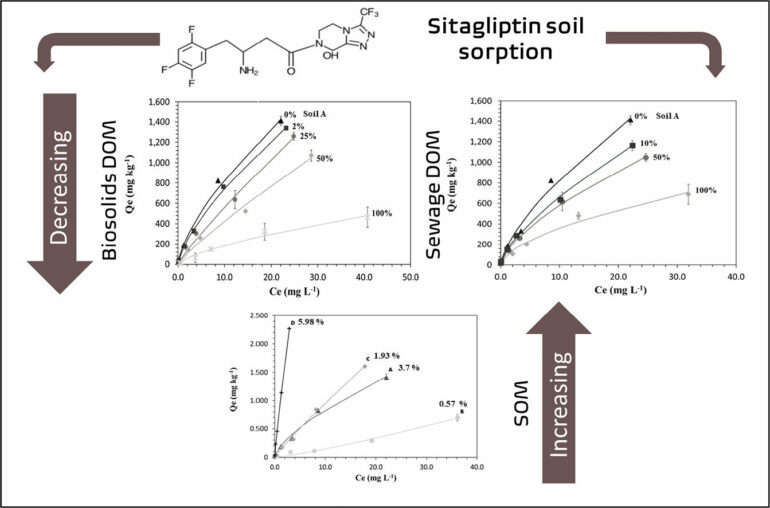The transport of pharmaceuticals released from sewage treatment plants into farmland soils, with the potential to load into drinking water sources, is one that researchers at the Illinois Sustainable Technology Center (ISTC) study carefully. Even at low concentrations, medications can affect water ecosystems and soil health.
“Applying sewage waste to crop fields is a win-win practice because it provides nutrients and organic matter to the soil and prevents waste sludge from ending up in landfills,” said Wei Zheng, ISTC environmental chemist. “The issue is that wastewater treatment plants cannot remove emerging contaminants and pharmaceuticals. We cannot ignore the potential risks from this practice.”
Biosolids, which are treated sewage sludge, are a product of the wastewater treatment process. Biosolids can be used on farmland to improve soil fertility, Zheng said.
In a recent study, Zheng and colleagues investigated the adsorption of sitagliptin in soils treated with sewage wastewater. Sitagliptin is commonly used to treat diabetes and is frequently detected in sewage effluent and the environment because it does not fully degrade during the wastewater treatment process. Lagoon-based sewage treatment systems in rural areas also remove fewer contaminants than typical municipal wastewater treatment facilities, so contaminant concentrations in sewage are higher.
Sitagliptin concentrations in the environment are unregulated in the United States. The drug is considered an emerging contaminant for its potential risk to the public.
Study findings showed that biosolids, which have a large amount of organic matter, bonded with the medication in soils and reduced its adsorption. Results also showed that increasing the amount of sewage effluent used for soil amendment reduced the adsorption of sitagliptin in soils.
Metformin is often prescribed, sometimes with sitagliptin, to treat diabetes. As part of this study, the researchers examined how this medication affects the uptake of sitagliptin in soils. Metformin is more water soluble, more degradable, and has less adsorption in soils than sitagliptin.
They found that increasing metformin concentrations in sewage effluent reduced the interaction of sitagliptin with the soil surface. This means that multiple pharmaceuticals and personal care products (PPCPs) in sewage can compete in soils, reducing the adsorption capacities of individual products.
“Some states have regulations for contaminants, such as per- and polyfluoroalkyl substances (PFAS), which are considered ‘forever chemicals,” in biosolids and sewage effluent, so over certain levels, biosolids cannot be used for soil amendments,” Zheng said. “In Illinois, there are no regulations, so it’s highly possible that organic chemical contaminants released from biosolids will leach to drinking water supplies, especially in rural areas. It is important to study and explore ways to minimize the leaching and runoff of PPCPs.”
The results of this study can be used to predict how other PPCPs are transported and adsorbed on agricultural soils and develop management strategies to reduce the risks of using sewage wastes in rural areas.
An article, “Influence of Biosolids and Sewage Effluent Application on Sitagliptin Soil Sorption,” was published in the journal Science of the Total Environment.
More information:
Alexander Ccanccapa-Cartagena et al, Influence of biosolids and sewage effluent application on sitagliptin soil sorption, Science of The Total Environment (2023). DOI: 10.1016/j.scitotenv.2023.165080
Provided by
Prairie Research Institute
Citation:
Scientists study how a diabetes drug affects soils (2023, August 9)
